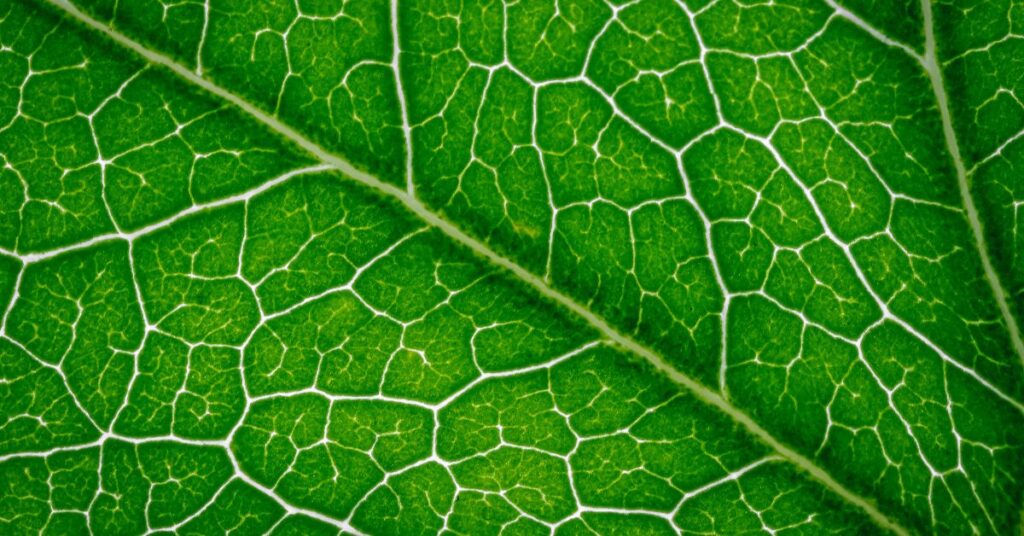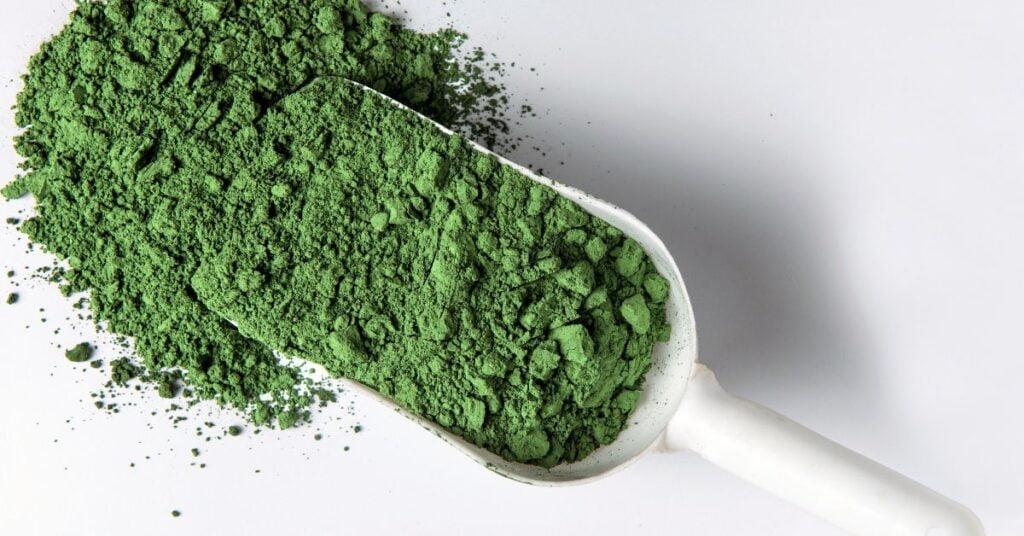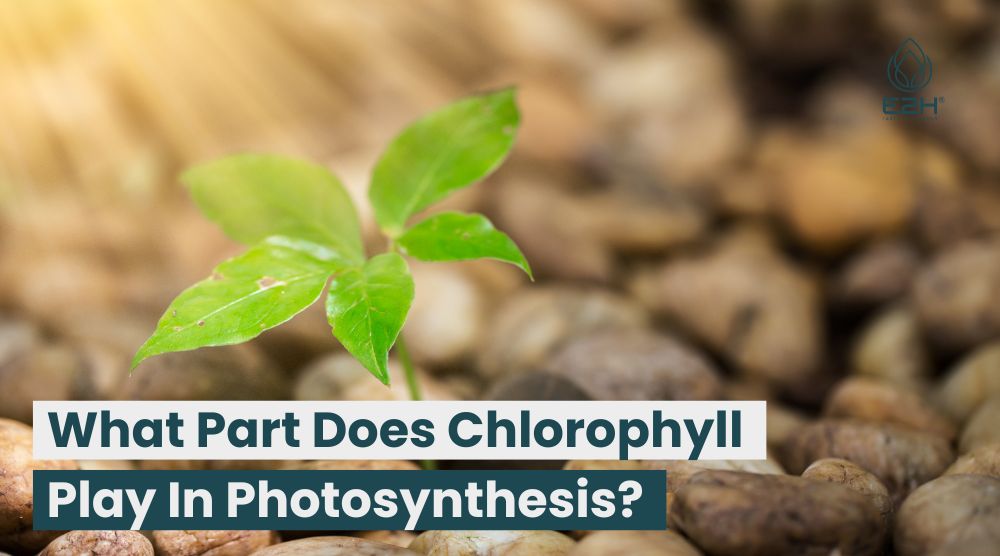Chlorophyll play a crucial role in photosynthesis by absorbing light energy and converting it into chemical energy. It is the pigment responsible for the green color of plants, and it is located in the chloroplasts of plant cells.
What is chlorophyll?
Chlorophyll is a green colour pigment found in the chloroplasts of green plants and other photosynthetic organisms. It is responsible for the green color of plants and is essential for photosynthesis. Chlorophyll is a complex molecule made up of a porphyrin ring and a phytol chain. The porphyrin ring is similar to the heme group found in hemoglobin, the protein that carries oxygen in the blood. Chlorophyll is involved in the absorption of light energy and its conversion into chemical energy.
What Part Does Chlorophyll Play In Photosynthesis?
Photosynthesis is a complex process that allows green plants and other photosynthetic organisms to harness light energy and convert it into chemical energy in the form of organic compounds. Chlorophyll plays a critical role in this process, as it is responsible for absorbing light energy and initiating the process of which photosynthesis takes place.
Chlorophyll is located in the chloroplasts of plant cells, where it acts as a photosensitizer, capturing photons of light and transferring them to the photosynthetic reaction center. The energy from red light absorbed by chlorophyll is then used to drive a series of chemical reactions that ultimately produce energy-rich compounds such as glucose.

Without chlorophyll, photosynthesis would not be possible, and green plants would be unable to produce the organic compounds necessary for their growth and survival. The vital role of chlorophyll in photosynthesis is, therefore, critical to the functioning of the entire ecosystem.
Moreover, chlorophyll is also responsible for the green color of plants, which is essential for attracting pollinators and ensuring the survival of many plant species. The beauty and diversity of the natural world are a direct result of the role that chlorophyll plays in photosynthesis, making it an incredibly important molecule for all life on earth.
Which chlorophyll play the most important role in photosynthesis?
Of all the types of chlorophyll found in plants, chlorophyll play the most important role in the process called photosynthesis. Chlorophyll a is the primary photosynthetic pigment and is responsible for capturing light energy and initiating the process of photosynthesis. It is the most efficient at absorbing light in the blue and red parts of the spectrum, which are the wavelengths most useful for photosynthesis. In addition, chlorophyll a is found in all photosynthetic organisms, from cyanobacteria to plants, suggesting that it has been conserved throughout the evolution of photosynthesis.
Chlorophyll b, on the other hand, is a secondary photosynthetic green colour pigment that plays a supportive role to chlorophyll play in photosynthesis. It absorbs light energies and passes it on to chlorophyll a, helping to extend the range of wavelengths of green light, that can be used for photosynthesis. Other types of chlorophyll, such as chlorophyll c and d, are found in certain algae and have specialized functions that are not found in plants.
Overall, while other types of chlorophyll have important roles to play in photosynthesis too, chlorophyll a is the most important pigment for capturing light energy and driving the process of photosynthesis.
What are the different types of chlorophyll?
There are several different types of chlorophyll, each with slightly different properties and functions. The most common types of chlorophyll found in green plants are chlorophyll a and chlorophyll b.
Chlorophyll a is the primary photosynthetic pigment, while chlorophyll b plays a secondary role by absorbing light energies and passing it on to chlorophyll a. In addition to these two types, there are other forms of chlorophyll found in different organisms, such as chlorophyll c and d in certain algae, and bacteriochlorophylls in photosynthetic bacteria. Each type of chlorophyll has a unique structure and absorbs light at different wavelengths, allowing photosynthetic organisms to optimize their use of available light energy.
What happens to chlorophyll during fall?
During fall, chlorophyll in plant leaves breaks down, leading to the loss of the green color that is characteristic of chlorophyll. This is due to the decreased sunlight and cooler temperatures that occur during the fall season.

As a result, the plant begins to break down the chlorophyll green pigment and reabsorb the nutrients for use in new growth the following spring. This process exposes other pigments that are normally masked by the presence of chlorophyll, such as carotenoids and anthocyanins, which give leaves their orange, yellow, and red colors.
This is why the leaves of many trees change color during the fall season. The breakdown of chlorophyll also marks the beginning of a period of dormancy for many plants, allowing them to conserve energy and prepare for the winter months ahead.
How does chlorophyll absorb light?
Chlorophyll absorbs light through a process called resonance energy transfer. When light strikes a chlorophyll molecule, the energy is absorbed by the pigment’s electrons, which become excited and enter a higher energy state.
The excited electrons then move through the chlorophyll molecule until they reach a reaction center, where they are used to drive the process of photosynthesis. Chlorophyll is particularly efficient at absorbing light in the blue and red parts of the spectrum, which are the wavelengths most useful for photosynthesis.
This ability to both absorb energy from light and transfer energy efficiently is what makes chlorophyll such an important pigment for the process of photosynthesis and for the survival of green plant.
Is green pigment called chlorophyll?
Yes, the green pigment found in plants and other photosynthetic organisms is called chlorophyll. Chlorophyll is a type of pigment that absorbs light energy and is responsible for initiating the process of photosynthesis. It is found in the chloroplasts of plant cells and gives plants their characteristic green color.

Chlorophyll is critical to the process of photosynthesis and is one of the most important molecules for plant life anywhere on Earth, as it allows green plants to produce the organic compounds necessary for their growth and survival.
Is chlorophyll only present in green plants?
No, chlorophyll is not only present in green plants. While chlorophyll is most commonly associated with green plant, it is also found in other photosynthetic organisms such as algae, some bacteria, and even some animals.
In fact, some animals such as sea slugs and some insects have evolved the ability to absorb and use chlorophyll from their food, allowing them to supplement their energy needs through photosynthesis.
Additionally, chlorophyll can be found in some non-photosynthetic organisms such as fungi, where it may have a role in regulating metabolism. So, while chlorophyll is most commonly associated with green plant, it is actually a more widely distributed pigment that plays a variety of roles in different organisms.
What a Photosystem Does for Photosynthesis?
Photosynthesis is the process by which plants and other photosynthetic organisms use light energy to convert carbon dioxide and water into organic compounds such as sugars. Photosynthesis is a complex process that involves several different components, one of which is the photosystem.
A photosystem is a large protein complex that is responsible for capturing light energy and converting it into chemical energy that can be used to drive the process of photosynthesis. There are two types of photosystems, Photosystem I (PSI) and Photosystem II (PSII), that work together in a coordinated manner to convert light energy into chemical energy.

PSII is responsible for capturing light energy and using it to split water molecules into oxygen and hydrogen ions. The oxygen is released into the atmosphere, while the hydrogen ions are used to power the production of ATP, a molecule that provides energy for the cell. PSI then uses the energy from PSII to produce NADPH, another molecule that is used to power the production of sugars and other organic compounds.
Overall, the photosystem helps plants is critical to the process of photosynthesis, as it allows plants to capture sunlight and convert light energy into chemical energy that can be used to power the production of organic compounds. Without the photosystem, photosynthesis would not be possible, and life as we know it on Earth would not exist.
Chlorophyll is necessary for Photosynthesis
FAQs
Can chlorophyll be synthesized artificially?
Yes, chlorophyll can be synthesized artificially, but it is not cost-effective.
Can chlorophyll be used for medicinal purposes?
Chlorophyll has been used for medicinal purposes, such as treating bad breath and body odor, but more research is needed to determine its efficacy.
Can chlorophyll supplements improve health?
There is limited evidence to support the use of chlorophyll supplements for improving health. Some studies suggest that it may have antioxidant and anti-inflammatory effects, but more research is needed to determine its effectiveness.
Conclusion
I think you got the answer of ‘What Part Does Chlorophyll Play In Photosynthesis’ this question. So, Chlorophyll plays a crucial role in photosynthesis by absorbing light energy and converting it into chemical energy. It is a complex pigment found in the chloroplasts of green plant and other photosynthetic organisms.
Liquid Chlorophyll is essential for the survival of all living organisms as it provides the necessary organic compounds and oxygen for life. Understanding the role of chlorophyll in photosynthesis is essential for appreciating the importance of green plant in the ecosystem and the impact of human activities on the environment.
His research and writing have been featured in numerous publications, and he is dedicated to helping people understand the importance of these vital nutrients in maintaining optimal health. If you're looking to improve your well-being through diet and nutrition, Christopher is the expert to turn to.
- Can I Take Maca and Ashwagandha Together: YES! - January 7, 2024
- Can You Take Ashwagandha And Liquid Chlorophyll Together: YES! - January 7, 2024
- Can You Take Shilajit and Ashwagandha Together? - January 7, 2024










